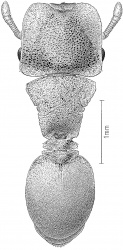Cephalotes caribicus
| †Cephalotes caribicus Temporal range: Burdigalian, Early Miocene Dominican amber, Dominican Republic | |
|---|---|

| |
| Scientific classification | |
| Kingdom: | Animalia |
| Phylum: | Arthropoda |
| Class: | Insecta |
| Order: | Hymenoptera |
| Family: | Formicidae |
| Subfamily: | Myrmicinae |
| Tribe: | Attini |
| Genus: | Cephalotes |
| Species: | †C. caribicus |
| Binomial name | |
| †Cephalotes caribicus De Andrade & Baroni Urbani, 1999 | |
One of a number of Cephalotes fossil species that are known from Dominican Amber. This species suggests Brazilian Chaco affinities previously unknown for the Dominican amber fauna. (de Andrade and Baroni Urbani 1999)
Identification
A member of the pinelii clade differing from its sister species, Cephalotes incertus, by the worker with the first gastral tergite with broad anterolateral membranaceous expansions but without true lobes. C. caribicus shares with incertus the pronotal crest followed by a close mesonotal tooth and the petiole bidentate dorsally. (de Andrade and Baroni Urbani 1999)
Distribution
This taxon was described from Dominican amber, Dominican Republic (Burdigalian, Early Miocene).
Castes
Nomenclature
The following information is derived from Barry Bolton's Online Catalogue of the Ants of the World.
- †caribicus. †Cephalotes caribicus De Andrade & Baroni Urbani, 1999: 418, figs. 15C, 191 (w.) DOMINICAN AMBER (Dominican Republic, Miocene).
Holotype: Staatliches Museum fur Naturkunde Stuttgart, no. DO-5383.
Paratype worker in the Dominican amber sample GOPC-5 in Oregon State University.
Unless otherwise noted the text for the remainder of this section is reported from the publication that includes the original description.
Description
Worker
Head broader than long. Frontal carinae very weakly crenulate only in their anterior part. Vertexal angles broad, round and membranaceous. Mandibles laterally carinate. Antennal club two-jointed.
Mesosoma. Scapular angles absent. Anterior pronotal border convex; pronotal sides with a broad, membranaceous expansion, subtruncate anteriorly and narrowing posteriorly. Promesonotal suture absent. Mesonotum with a pair of lateral, truncate, teeth narrowly separate from the pronotal and propodeal expansions. Propodeal suture superficially impressed on the sides only. Declivous face of the propodeum gently sloping backwards. Basal and declivous faces of the propodeum with a narrow, membranaceous expansion originating cranially on the basal face and slightly narrowing backwards.
Petiole with the anterior face deeply concave and with a pair of small dorsal swellings; petiole dorsally and anteriorly depressed; its sides with a broad, round, wing-shaped, membranaceous expansion directed laterally. Postpetiole with a comparably broad, wing-shaped, membranaceous expansion rounded apically and directed laterally.
Gaster suboval and with broad, anterolateral, membranaceous expansions.
Hind femora angulate. Mid and hind basitarsi with flat and extremely broad base.
Sculpture. Head dorsum minutely punctate, with small, superficial foveae variably clumped, sparser and shallower on the frontal carinae. Ventral part of the head minutely reticulate-punctate. Mesosoma and pedicel reticulate-punctate and with foveae, sparser on the propodeum. First gastral tergite and legs reticulate, the same type of sculpture but more superficial on the first gastral sternite.
Pilosity. Body foveae with appressed hairs. Borders of the vertexal angles, of the propodeum, of the pedicel and posterior borders of the second and third gastral tergites with rare, short clubbed hairs. Gaster and legs with sparse, thin, short, appressed hairs. Second gastral sternite with a pair of long, erect, pointed hairs.
Colour indistinguishable (both specimens are covered by a thin gaseous film). Frontal carinae, vertexal angles and membranaceous expansions semitransparent.
Measurements (in mm) and indices: TL 3.97-4.64; HL 0.98-1.04; HW 1.27-1.32; EL 0.23-0.25; PW 1.04-1.18; PeW 0.52; PpW 0.55; HBaL 0.30-0.34; HBaW 0.15; CI 126.9-129.6; PI 111.9-122.1; PPeI 200.0-226.9; PPpI 189.1-214.5; HBaI 46.9-50.0.
Etymology
Caribicus is a neologism referring to the area of provenance of this species.
References
- de Andrade, M. L.; Baroni Urbani, C. 1999. Diversity and adaptation in the ant genus Cephalotes, past and present. Stuttgarter Beitrage zur Naturkunde Series B (Geolgie and Palaontologie). 271:1-889. (page 418, figs. 15C, 191 worker d*Price, S.L., Blanchard, B.D., Powell, S., Blaimer, B.B., Moreau, C.S. 2022. Phylogenomics and fossil data inform the systematics and geographic range evolution of a diverse Neotropical ant lineage. Insect Systematics and Diversity 6(1): 9 (doi:10.1093/isd/ixab023).
escribed)


